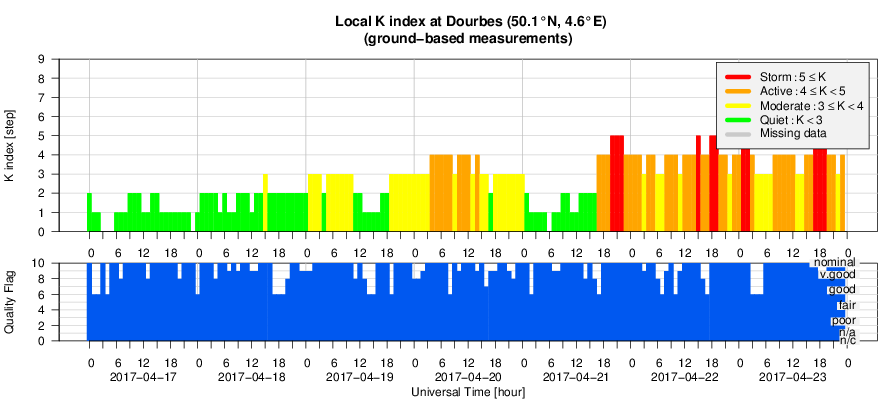- Table of Content
- 1.Works in progr...
- 2.Birkeland: 150...
- 3.PROBA2 Observa...
- 4.Review of sola...
- 5.The Internatio...
- 6.Geomagnetic Ob...
- 7.Review of iono...
- 8.Future Events
2. Birkeland: 150 and 100 years jubilee
3. PROBA2 Observations (17 Apr 2017 - 23 Apr 2017)
4. Review of solar and geomagnetic activity
5. The International Sunspot Number
6. Geomagnetic Observations at Dourbes (17 Apr 2017 - 23 Apr 2017)
7. Review of ionospheric activity (17 Apr 2017 - 23 Apr 2017)
8. Future Events
Works in progress!...
Underneath a few highlights of projects, important for solar and space weather monitoring and research, that are in the process of being tested on ground or in space.
Solar Orbiter's EUI
Late February (see news item at http://www.stce.be/news/377/welcome.html ), we reported already on the Extreme Ultraviolet Imager being put together at the CSL (Centre Spatial de Liège, Belgium). Two months later, not only is this instrument fully assembled, it has also been aligned, thermal-vacuum tested, and has undergone an extensive vibration testing ("Shaken, not stirred"). Last week, it has been shipped to PTB (Physikalisch-technische Bundesanstalt; http://www.ptb.de/cms/ ) for final calibration at a synchrotron source (particle accelerator). The final issues are being addressed and the instrument is ready for its scheduled delivery to ESA in May. EUI is an instrument that will be onboard the ESA space mission Solar Orbiter, which is scheduled for launch in February 2019.
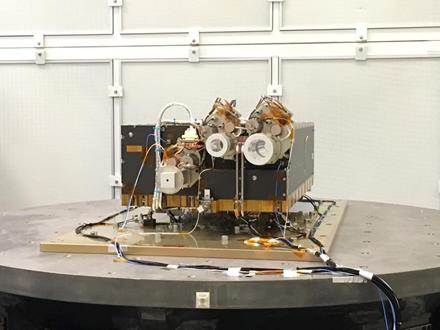
SPADE
No, a UFO has not landed next to the ROB's canteen. This is actually a radio telescope and part of the SPADE project (funded by BELSPO, through a BRAIN-BE grant: https://www.belspo.be/belspo/brain-be/projects/SPADE_en.pdf ). SPADE stands for Small Phased Array DEmonstrator and is aimed at observing the Sun. It will produce dynamic spectra of the Sun between 20 and 80 MHz with high sensitivity. An array consisting of eight of these low-cost radio telescopes will be deployed at the radio astronomy station of Humain, near Marche-en-Famenne (Belgium). But first of course, the instrument has to be tested, which is what the folks at the Royal Observatory of Belgium (ROB) are currently doing.
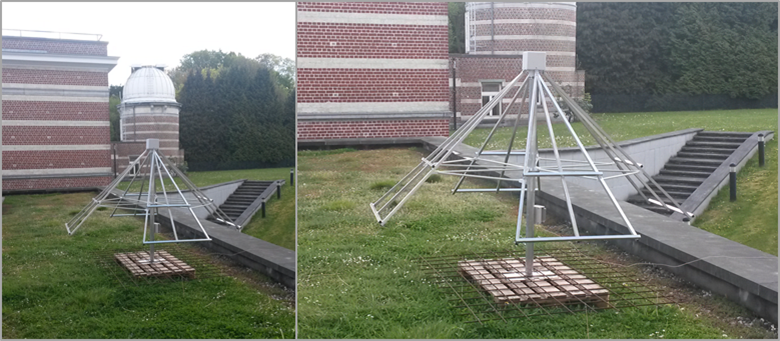
SUVI
Last week, we reported on an impressive C5 solar eruption (see news item at http://www.stce.be/news/386/welcome.html ). The Solar Ultraviolet Imager onboard the GOES-16 satellite (SUVI, see news item at http://www.stce.be/news/378/welcome.html ) is still in its in-orbit testing phase, but was fortunate to observe the Sun at the time of the dramatic flare. It provides a view on the opening, then closing of the magnetic field loops, and the development of the post-flare coronal loops. More movies in different passbands are at the GOES-16 webpage (https://www.nesdis.noaa.gov/content/goes-16-solar-images ). GOES-16 was launched on 19 November 2016, with SUVI making its first images on 29 January 2017.
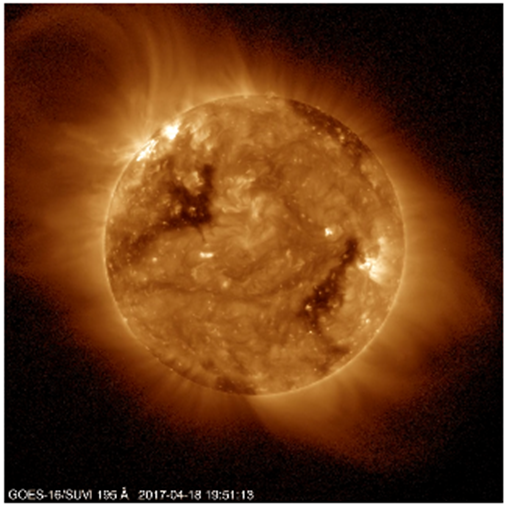
Birkeland: 150 and 100 years jubilee
INVITATION
The registration for the Birkeland Symposium in Oslo is now open.
Main Page: http://www.mn.uio.no/english/about/news-and-events/events/The%20Birkeland%20Anniversary/
Birkeland Symposium: http://www.mn.uio.no/english/about/news-and-events/events/The%20Birkeland%20Anniversary/the-birkeland-anniversary-15-june.html
Under "Please Register" you can also indicate if you want to give a contributed talk. The program fro the first day (15th June) is all set. But if you select that you also want to participat on the 16th - new options will appear - such as what session, title of talt etc.
This is a free event - no registration fee. Lunch and refreshment breaks on 15 and 16 June will be provided to Symposium participants free of charge.
We hope to see many of you that week.
Pål Brekke, Norwegian Space Centre

PROBA2 Observations (17 Apr 2017 - 23 Apr 2017)
Solar Activity
Solar flare activity fluctuated between very low and low during the week.
In order to view the activity of this week in more detail, we suggest to go to the following website from which all the daily (normal and difference) movies can be accessed: http://proba2.oma.be/ssa
This page also lists the recorded flaring events.
A weekly overview movie can be found here (SWAP week 369):
http://proba2.oma.be/swap/data/mpg/movies/weekly_movies/weekly_movie_2017_04_17.mp4
Details about some of this week's events, can be found further below.
If any of the linked movies are unavailable they can be found in the P2SC movie repository here:
http://proba2.oma.be/swap/data/mpg/movies/
Monday Apr 17
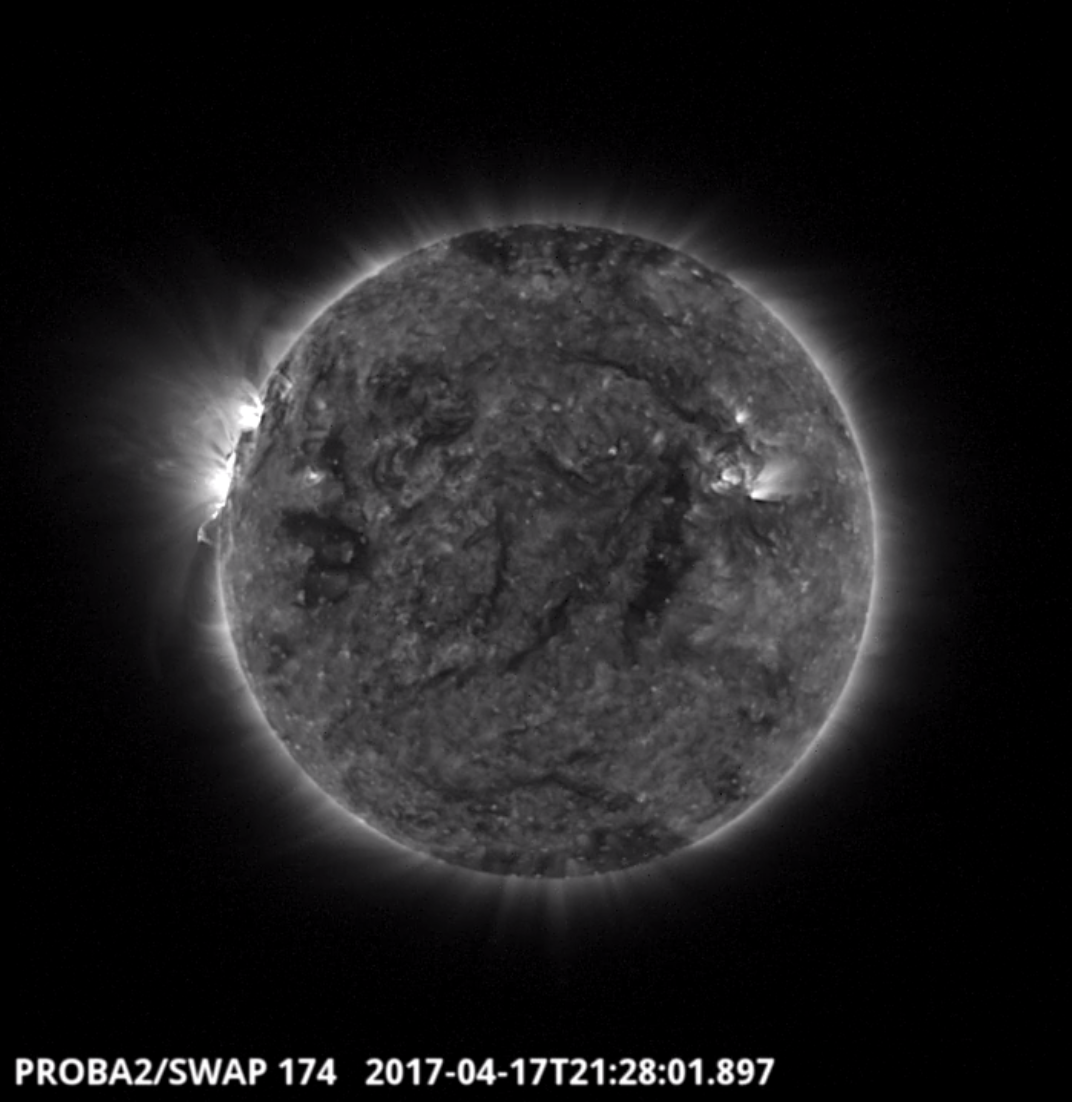
Active region NOAA 2651 began to appear over the east limb of the Sun at the start of the week and was associated with multiple B- and C-class flares. SWAP observed an eruption associated with a B7.5 flare shown here on the east limb at 21:28 UT on 17-Apr-2017.
Find a movie of the event here (SWAP movie):
http://proba2.oma.be/swap/data/mpg/movies/20170417_swap.mp4
Tuesday Apr 18
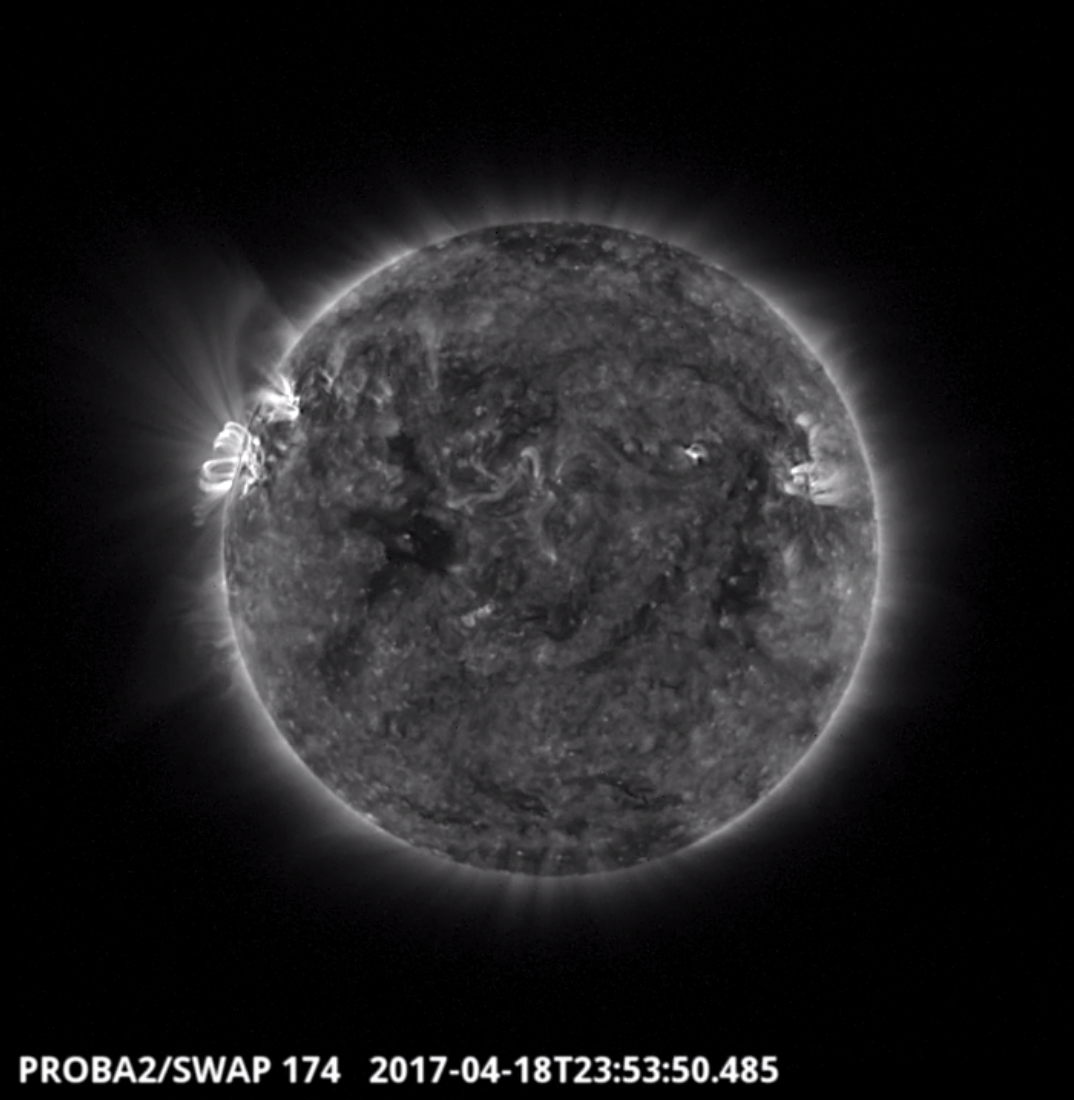
Two CMEs from active region NOAA 2651 occurred on 18-Apr-2017 towards the eastern limb of the Sun. The post eruptive flare loops associated with the second eruption are shown here at 23:53 UT.
Find a movie of the event here (SWAP movie):
http://proba2.oma.be/swap/data/mpg/movies/20170418_swap.mp4
Review of solar and geomagnetic activity
SOLAR ACTIVITY
The week started with NOAA AR 2651 rotating over the east limb and producing 3 C-class flares, the strongest one was a C5.5 on 18 April at 20:10 UT. This region presented a beta-gamma magnetic field configuration but then decayed into beta configuration on April 20 and did not produce any more flares after that. Other two ARs were present, NOAA ARs 2652 and 2653 but did not produce any activity. The C5.5 flare was related to a partial halo CME with speeds of around 900 km/s directed towards the east.
GEOMAGNETIC ACTIVITY
On April 19-20 the high speed stream from an equatorial (positive) coronal hole arrived to the Earth. The solar wind speed raised to 600 km/s with interplanetary magnetic fields of 15 nT. It produced major storm at planetary levels (Kp = 6) and active conditions locally at Dourbes (K = 4). On April 21 a short glancing blow from the CME on April 18 was seen at the Earth, together with the arrival of the high speed stream from another (negative) coronal hole with speeds reaching 800 km/s and interplanetary magnetic fields of 12 nT. The influence of this high speed stream continued until the end of the week (and beyond) and it produced Kp = 6 and K =5.
Relive the SIDC space weather briefing:

The International Sunspot Number
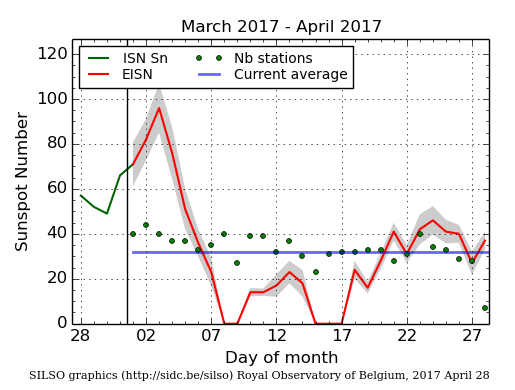
The daily Estimated International Sunspot Number (EISN, red curve with shaded error) derived by a simplified method from real-time data from the worldwide SILSO network. It extends the official Sunspot Number from the full processing of the preceding month (green line). The plot shows the last 30 days (about one solar rotation). The horizontal blue line shows the current monthly average, while the green dots give the number of stations included in the calculation of the EISN for each day.
Review of ionospheric activity (17 Apr 2017 - 23 Apr 2017)
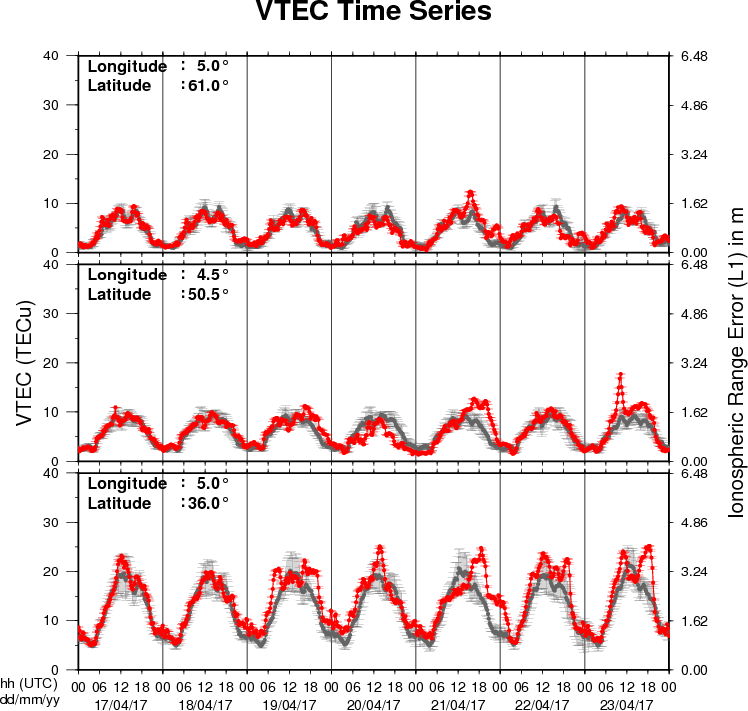
The figure shows the time evolution of the Vertical Total Electron Content (VTEC) (in red) during the last week at three locations:
a) in the northern part of Europe(N61°, 5°E)
b) above Brussels(N50.5°, 4.5°E)
c) in the southern part of Europe(N36°, 5°E)
This figure also shows (in grey) the normal ionospheric behaviour expected based on the median VTEC from the 15 previous days.
The VTEC is expressed in TECu (with TECu=10^16 electrons per square meter) and is directly related to the signal propagation delay due to the ionosphere (in figure: delay on GPS L1 frequency).
The Sun's radiation ionizes the Earth's upper atmosphere, the ionosphere, located from about 60km to 1000km above the Earth's surface.The ionization process in the ionosphere produces ions and free electrons. These electrons perturb the propagation of the GNSS (Global Navigation Satellite System) signals by inducing a so-called ionospheric delay.
See http://stce.be/newsletter/GNSS_final.pdf for some more explanations ; for detailed information, see http://gnss.be/ionosphere_tutorial.php
Future Events
For more details, see http://www.spaceweather.eu/en/event/future
URSI General Assembly in Montreal, Canada
Start : 2017-08-19 - End : 2017-08-26
For the thirty-second time since the inception of URSI, Radio
Scientists from across the world will get together for the URSI
General Assembly and Scientific Symposium. This triennial gathering
will take place from 19th to 26th of August 2017, in Montreal,
Canada. This conference is a unique opportunity to learn about
recent advances in all fields of Radio Science, as covered by all
ten URSI Commissions.
Among the different sessions, please note:
* 'Radio Science for Space Weather'
Conveners: M. Messerotti, V. Pierrard
* 'Remote Sensing and Modeling of the Earth's Plasmasphere
and Plasmapause'
Conveners: A. M. Jorgensen, V. Pierrard, B. Heilig
The abstract deadline is 30 January 2017
Website: http://www.ursi2017.org
2017 Joint IAPSO-IAMAS-IAGA Assembly in Cape Town, South Africa
Start : 2017-08-27 - End : 2017-09-01
The Joint IAPSO-IAMAS-IAGA Assembly, endorsed by the University
of Cape Town and the South African Department of Science and
Technology, will take place from 27 August to 1 September 2017 at
the Cape Town International Convention Centre (CTICC). Several IAGA
and IAMAS sessions are of Space Weather interests as well as the
joint session 'Space Weather throughout the Solar System: Bringing
Data and Models together'.
Website:
http://iapso-iamas-iaga2017.com/index.php
Workshops on Radiation Monitoring for the International Space Station in Torino, Italy
Start : 2017-09-05 - End : 2017-09-07
The Workshop on Radiation Monitoring for the International Space
Station is an annual meeting to discuss the scientific definition
of an adequate radiation monitoring package and its use by the
scientific community on the ISS. Types of instruments and research
topics need to be defined in order to optimise the radiation safety
of the ISS crew.
Website: http://wrmiss.org/
International Workshop on Solar, Heliospheric & Magnetospheric Radioastronomy in Meudon, France
Start : 2017-11-06 - End : 2017-11-10
Jean-Louis Steinbeg has been one of the major pioneers in
radioastronomy. Co-founder of the Nançay Observatory, he
has actively participated to, an inspired a large number of radio
instruments on many international space missions. Jean-Louis
Steinberg is the founder of the Space Radioastronomy laboratory of
the Paris Observatory in 1963. Later on, this laboratory widened
its science interests and became the DESPA (1971) and then the
current LESIA (2002) which is one of the major space sciences
laboratories in France. The aim of this workshop is to cover the
science topics which Jean-Louis Steinberg has promoted during his
career, focusing on Solar, Heliospheric & Magnetospheric
radioastronomy & physics. This will be done by covering both
observations from either ground facilities (NDA, RH, LOFAR, Artemis
etc ...) or space missions (ISSEE, Ulysses, WIND, CLUSTER, STEREO,
CASSINI, JUNO etc ...) and models/theories. A series of invited
talks is also foreseen to cover the new developments in the
discipline which may come with the future facilities such as Solar
Orbiter, Solar Probe Plus, JUICE, JUNO, LOFAR+, SKA etc ....
This workshop will also be the opportunity to remember both the
extraordinary personal & professional lifes of Jean-Louis
Steinberg especially for new generation of scientists. At the
occasion of this workshop it is also expected that the Building 16
(historical Space Sciences building) on the Meudon campus will be
renamed "Building Jean-Louis Steinberg".
Website:
https://jlsworkshop.sciencesconf.org/
European Space Weather Week 14
Start : 2017-11-27 - End : 2017-12-01
The ESWW is the main annual event in the European Space Weather
calendar. It is the European forum for Space Weather as proven by
the high attendance to the past editions. The agenda will be
composed of plenary/parallel sessions, working meetings and
dedicated events for service end-users. The ESWW will again adopt
the central aim of bringing together the diverse groups in Europe
working on different aspects of Space Weather.
Website:
http://www.stce.be/esww14/
